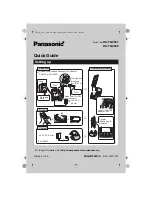
1.20 Portable Station (PS) Features
146
Feature Guide
1.20 Portable Station (PS) Features
1.20.1 Portable Station (PS) Connection
Description
A Panasonic KX-TD7680 or KX-TD7690 portable station (PS) can be used in place of a proprietary
telephone (PT), providing wireless access to PBX features and call handling.
1.
Registration
Before a PS can be used, it must be registered with the PBX through system programming (
Registration [690]) and assigned an extension number.
Because a PS transmits radio waves, it is possible that a PS belonging to a neighboring PBX can be
registered to your PBX. To prevent this sort of unauthorized registration, a personal identification
number (PIN) can be programmed for this PBX that must be entered on the PS during registration. (
Personal Identification Number (PIN) for PS Registration [692]). This PIN, if programmed, is only used
during the PS registration process.
Each PS can be registered to more than one PBX if necessary, and registration can be canceled if a
PS will no longer be used with one of these PBXs. (
2.
Connection
There are two ways a PS can be used.
As an Extension
A PS is assigned its own extension number when it is registered to a PBX. The PS can use this
extension number to make and receive calls, just as a wired telephone can. A PS can be a member of
an incoming call distribution (ICD) group, can be assigned as the destination for redirected calls, etc.,
just as a wired telephone can.
A PS can also be a member of a PS ring group (
1.20.2 PS Ring Group). A PS ring group is a way
for several PSs to be notified of an incoming call simultaneously, but does not offer all of the features
provided by an ICD group. (
1.2.2 Incoming Call Distribution (ICD) Group Features)
In Wireless XDP Parallel Mode
A PS can share an extension number with a wired telephone, allowing extension users to use their PSs
when they are away from their desks to answer or make calls as if they were using their wired
telephones. (
1.20.3 Wireless XDP Parallel Mode)
3.
PS Interaction with CS
Each PS communicates with the PBX wirelessly through a cell station (CS). Each CS is connected to
the PBX and sends and receives radio waves to and from different PSs within its range, using different
channels for different PSs. Each CS has two channels, i.e., up to two calls (conversations) can be
handled simultaneously by one CS.
A PS must be within range of a CS in order to be used, however, multiple CSs can be used with the
same PBX to offer a greater area of wireless coverage. Additionally, a PS does not need to be used
with a specific CS; any PS can communicate with any CS provided the PS is registered to the PBX, and
provided the CS has at least one channel available.
Handover
If a PS is within range of more than one CS, the PS will communicate with the CS which has the greatest
signal strength and an available channel. When a PS user moves out of range of one CS and moves in
Summary of Contents for KX- TAW848
Page 5: ...Feature Guide 5 V VM Voice Mail VPS Voice Processing System X XDP eXtra Device Port ...
Page 13: ...Feature Guide 13 Section 1 Call Handling Features ...
Page 60: ...1 5 Making Call Features 60 Feature Guide User Manual References 1 2 1 Basic Calling ...
Page 167: ...Feature Guide 167 Section 2 System Configuration and Administration Features ...
Page 182: ...2 2 System Configuration Software 182 Feature Guide 3 2 2 Manager Programming ...
Page 196: ...2 4 Fault Recovery Diagnostics 196 Feature Guide ...
Page 197: ...Feature Guide 197 Section 3 Programming Instructions ...
Page 232: ...3 3 PT Programming 232 Feature Guide ...
Page 233: ...Feature Guide 233 Section 4 KX TAW848 Maintenance Console Operating Instructions ...
Page 545: ...4 14 ARS 8 Feature Guide 545 Feature Guide References 1 9 1 Automatic Route Selection ARS ...
Page 568: ...4 16 Maintenance 10 568 Feature Guide ...
Page 569: ...Feature Guide 569 Section 5 Appendix ...
Page 577: ...Feature Guide 577 Index ...
Page 583: ...Index Feature Guide 583 ...
















































